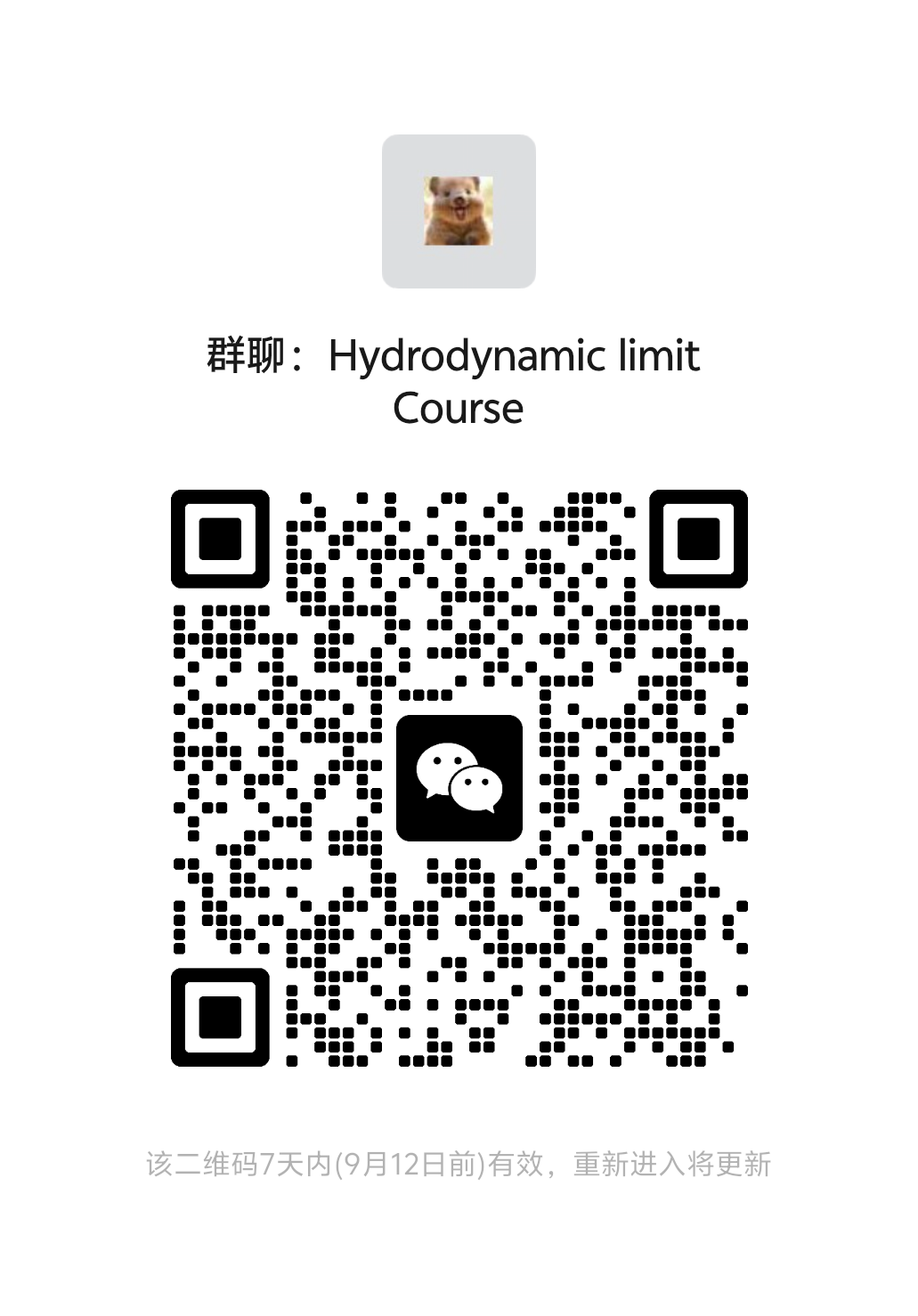Hydrodynamic limit from stochastic interacting systems
We will discuss the derivation of nonlinear PDEs (partial differential equations) from microscopic stochastic interacting systems. This procedure is symbolically called the hydrodynamic limit because it goes through local equilibrium states, with the averaging effect due to local ergodicity playing an essential role. We will also consider fluctuations and discuss the derivation of stochastic PDEs.

讲师
日期
2025年09月15日 至 12月22日
位置
| Weekday | Time | Venue | Online | ID | Password |
|---|---|---|---|---|---|
| 周一,周三 | 09:50 - 11:25 | A3-2-301 | ZOOM 05 | 293 812 9202 | BIMSA |
修课要求
It is desirable that the audience is familiar with some tools in stochastic analysis such as martingales and stochastic differential equations, cf. [1], [2].
课程大纲
The course consists of the following three parts.
(1) Interacting particle systems, cf. [3], [4], [5]
Exclusion process (Kawasaki dynamics), Zero-range process, Glauber dynamics, Basic facts and tools.
(2) Hydrodynamic scaling limit and fluctuation limit, cf. [3], [6], [7], [12]
Background, Short history of the hydrodynamic limit, Independent random walks as warm-up, Entropy method (Varadhan), One block estimate, Two blocks estimate, Equilibrium fluctuation, Boltzmann-Gibbs principle, Relative entropy method (H.T. Yau), Large deviation, Non-gradient model, Method from quantitative homogenization, Concentration inequality.
(3) Applications and extensions of these methods, cf. [8]-[15]
Derivation of curvature flow for interfaces in phase separation phenomena, Fluctuation of interfaces, Fluctuating hydrodynamics, Coupled KPZ equation.
(1) Interacting particle systems, cf. [3], [4], [5]
Exclusion process (Kawasaki dynamics), Zero-range process, Glauber dynamics, Basic facts and tools.
(2) Hydrodynamic scaling limit and fluctuation limit, cf. [3], [6], [7], [12]
Background, Short history of the hydrodynamic limit, Independent random walks as warm-up, Entropy method (Varadhan), One block estimate, Two blocks estimate, Equilibrium fluctuation, Boltzmann-Gibbs principle, Relative entropy method (H.T. Yau), Large deviation, Non-gradient model, Method from quantitative homogenization, Concentration inequality.
(3) Applications and extensions of these methods, cf. [8]-[15]
Derivation of curvature flow for interfaces in phase separation phenomena, Fluctuation of interfaces, Fluctuating hydrodynamics, Coupled KPZ equation.
参考资料
[1] J-F. Le Gall, Brownian motion, martingales, and stochastic calculus, Springer, 2013.
[2] I. Karatzas and S.E. Shreve, Brownian motion and stochastic calculus, Springer, 1991.
[3] C. Kipnis and C. Landim, Scaling limits of interacting particle systems, Springer, 1999.
[4] T.M. Liggett, Interacting particle systems, Springer, 1985.
[5] T.M. Liggett, Stochastic interacting systems: contact, voter and exclusion processes, Springer, 1999.
[6] T. Funaki, Hydrodynamic limit for exclusion processes, Commun. Math. Stat., 6 (2018), 417-480.
[7] T. Funaki, Hydrodynamic limit and stochastic PDEs related to interface motion, ICM2022 Proceedings, EMS Press.
[8] T. Funaki, P. van Meurs, S. Sethuraman and K. Tsunoda, Motion by mean curvature from Glauber-Kawasaki dynamics with speed change, J. Statis. Phys., 190 (2023), Article no. 45, 1-30.
[9] T. Funaki, P. van Meurs, S. Sethuraman and K. Tsunoda, Constant-speed interface flow from unbalanced Glauber-Kawasaki dynamics, Ensaios Matematicos, 38 (2023), 223-248.
[10] C. Bernardin, T. Funaki and S. Sethuraman, Derivation of coupled KPZ-Burgers equation from multi-species zero-range processes, Ann. Appl. Probab., 31 (2021), 1966-2017.
[11] T. Funaki, Interface motion from Glauber-Kawasaki dynamics of non-gradient type, arXiv:2404.18364v2
[12] T. Funaki, C. Gu and H. Wang, Quantitative homogenization and hydrodynamic limit of non-gradient exclusion process, arXiv:2404.12234
[13] T. Funaki and H. Park, Motion of sharp interface of Allen-Cahn equation with anisotropic nonlinear diffusion, arXiv:2403.01732
[14] T. Funaki, C. Landim and S. Sethuraman, Linear fluctuation of interfaces in Glauber-Kawasaki dynamics, arXiv:2412.04015
[15] T. Funaki, Stochastic PDE approach to fluctuating interfaces, arXiv:2412.00708
[2] I. Karatzas and S.E. Shreve, Brownian motion and stochastic calculus, Springer, 1991.
[3] C. Kipnis and C. Landim, Scaling limits of interacting particle systems, Springer, 1999.
[4] T.M. Liggett, Interacting particle systems, Springer, 1985.
[5] T.M. Liggett, Stochastic interacting systems: contact, voter and exclusion processes, Springer, 1999.
[6] T. Funaki, Hydrodynamic limit for exclusion processes, Commun. Math. Stat., 6 (2018), 417-480.
[7] T. Funaki, Hydrodynamic limit and stochastic PDEs related to interface motion, ICM2022 Proceedings, EMS Press.
[8] T. Funaki, P. van Meurs, S. Sethuraman and K. Tsunoda, Motion by mean curvature from Glauber-Kawasaki dynamics with speed change, J. Statis. Phys., 190 (2023), Article no. 45, 1-30.
[9] T. Funaki, P. van Meurs, S. Sethuraman and K. Tsunoda, Constant-speed interface flow from unbalanced Glauber-Kawasaki dynamics, Ensaios Matematicos, 38 (2023), 223-248.
[10] C. Bernardin, T. Funaki and S. Sethuraman, Derivation of coupled KPZ-Burgers equation from multi-species zero-range processes, Ann. Appl. Probab., 31 (2021), 1966-2017.
[11] T. Funaki, Interface motion from Glauber-Kawasaki dynamics of non-gradient type, arXiv:2404.18364v2
[12] T. Funaki, C. Gu and H. Wang, Quantitative homogenization and hydrodynamic limit of non-gradient exclusion process, arXiv:2404.12234
[13] T. Funaki and H. Park, Motion of sharp interface of Allen-Cahn equation with anisotropic nonlinear diffusion, arXiv:2403.01732
[14] T. Funaki, C. Landim and S. Sethuraman, Linear fluctuation of interfaces in Glauber-Kawasaki dynamics, arXiv:2412.04015
[15] T. Funaki, Stochastic PDE approach to fluctuating interfaces, arXiv:2412.00708
听众
Advanced Undergraduate
, Graduate
, 博士后
, Researcher
视频公开
公开
笔记公开
不公开
语言
英文
讲师介绍
Funaki Tadahisa曾任东京大学教授,后任早稻田大学教授,2022年加入北京雁栖湖应用数学研究院任研究员。2007年获得日本数学会秋季奖,2022年国际数学家大会受邀报告人,曾担任日本数学会理事长。他的主要研究与统计物理学有关概率论,特别是相互作用系统和随机偏微分方程,而随着几个菲尔兹奖被授予这些领域,其重要性也在逐步增加。




